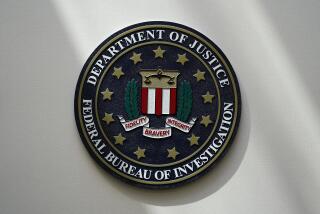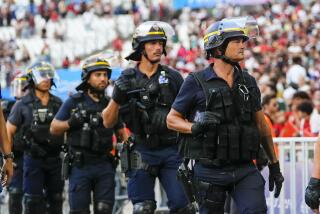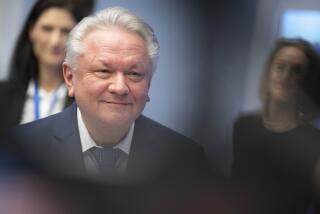U.S. Believes More Attacks Are Planned
WASHINGTON — U.S. intelligence officials believe that Osama bin Laden long ago began orchestrating a significant terrorist counterpunch to the expected U.S. retaliation for the attacks on New York and the Pentagon, a Bush administration official said Saturday.
The official said there is “no doubt” that Bin Laden has planned a response to anticipated United States military strikes.
“He has gamed out the next two or three moves already. He expects us to respond to the World Trade Center, and he has the next move planned after that,” the official said.
“You don’t take as much time as he has and not have planned several moves,” added the official, speaking on condition of anonymity. “It’s not about bloodying our nose and putting fear into us. He has a broader, strategic objective.”
That assessment is shared by top intelligence and counter-terrorism experts, the official said, and has been conveyed to top political, diplomatic and military advisors and other high-ranking members of the Bush administration. It is based on intelligence information, a detailed assessment of how Bin Laden and his Al Qaeda network operate, and interrogations of people detained in the United States and Europe in the wake of the Sept. 11 attacks against the World Trade Center and the Pentagon.
Authorities have also shared their information about expected future attacks with counter-terrorism officials in Europe and elsewhere.
White House spokesman Ari Fleischer had no direct comment Saturday on whether the administration believes that Bin Laden and his operatives have already laid the groundwork for further attacks.
“I’m not going to speculate on a hypothetical on top of a hypothetical,” Fleischer said. “But there is no question that terrorism presents a challenge to the country. It has in the past, and it may do so again. And that is why the president has demonstrated such resolve in going to battle against terrorists and nations that harbor them so we can forever reduce their ability to strike anyone anywhere.”
Maj. Tim Blair, a Pentagon spokesman, when asked about the view of Bin Laden’s planned response to any U.S. attack, said, “All of that is either [about] operations or intelligence. Those are categories we are just not prepared to talk about.”
President Bush has identified Bin Laden and Al Qaeda as the prime suspects in the suicide hijackings, which killed nearly 7,000 people. Bin Laden is also believed to be responsible for the bombings of two U.S. embassies in Africa in 1998 and the terrorist attack on the U.S. destroyer Cole in Yemen last year.
Authorities fear that the Bin Laden operatives who would carry out such terrorist attacks may already be in place, hidden and ready to go--just as they were before Sept. 11. To find them, the administration has deployed federal agents and intelligence operatives across the United States and around the world.
At the same time, the United States has sent numerous warships and thousands of troops to Central Asia, positioning them for a possible attack on Afghanistan, where Bin Laden is believed to be hiding.
Federal officials also have beefed up security at potential targets, such as airports, military installations and power plants.
To date, however, the administration still does not know whether retaliatory attacks would be launched within the United States or against American civilian, commercial and military targets elsewhere in the world, the official said.
“His men have outstanding operational security, they are meticulous, their plans are well thought out and they are in it for religious and ideological goals,” the official said of Bin Laden. “If we had the answers to those questions--when, where and how--we’d all be heroes. If Sept. 11 taught us anything, it was to not use the previous template of their attack profile as a guide. They hit a different target every time.”
Concern Paid to Sending U.S. Soldiers Into Trap
Federal law enforcement authorities confirmed Saturday that they have received classified briefings dealing with just such a situation, in which retaliatory strikes are launched by terrorists once the United States begins a military operation aimed at getting Bin Laden, his network and other terrorists.
“We know that there are other terrorists out there and that the threats could be growing,” said one federal law enforcement official. “What we have to do now is just be prepared.”
Another federal law enforcement official confirmed that a significant number of federal agents are not participating in the current investigation into the attacks. Instead, they are being held in reserve in anticipation of possible secondary attacks.
The comments by the official mark the first time that the Bush administration has said it believes that Bin Laden and Al Qaeda already have in place follow-up attacks and an infrastructure for carrying them out.
For that reason, the administration is wary of sending soldiers or special forces into a trap, the official said, or of being perceived as provoking another deadly wave of terrorism.
According to the official, Bin Laden “assumes we’ll strike at Afghanistan. The theory is that he has two or three [responses] already keyed up. He assumes we will fail and that they can immediately strike back. But even if he dies, plans for his organization continue and whatever attack is out there is on a dead switch; the people are in place and the authorization is there so that if a military strike comes, they will put it in motion.”
In the last several weeks, administration officials have warned that they believe that there exists a “clear and present danger” of more terrorist attacks. A pattern of follow-up attacks is in line with information provided to authorities by Ahmed Ressam, a convicted terrorist who is telling authorities about the workings of Bin Laden’s network after having spent eight months in two terrorist training camps in Afghanistan.
In a wide-ranging investigation, authorities have arrested or detained more than 480 people, temporarily grounded crop-duster planes and scoured records for information about people licensed to transport hazardous materials.
Administration sources also confirmed Saturday that they believe that three men now in custody were in some way connected to terrorist plots. They are trying to determine whether the three men were involved in the Sept. 11 attacks or were part of some future terrorist acts that would follow U.S. military strikes against Bin Laden and his network.
One of those men, Habib Zacharias Moussaoui, was detained in Minnesota a month before the suicide hijackings of Sept. 11. The other two, Mohammed Jaweed Azmath and Ayub Ali Khan, were taken into custody on an Amtrak train in Texas on Sept. 12; the commercial airliner they had been flying on was grounded in St. Louis just hours after the four hijacked planes crashed into the World Trade Center, the Pentagon and a field in rural Pennsylvania.
In other developments Saturday, arrests and additional information appeared to support evidence of ties between some of the 19 suspected hijackers and individuals living in Europe.
German authorities announced that they had arrested three men connected to a suspect in the Sept. 11 attacks, on charges of planning terrorist acts against German targets.
The Federal Prosecutor’s Office in Karlsruhe described the three men as a Turkish citizen and two Yemenis and said they tracked the suspects through their Internet activity to a Wiesbaden apartment. By doing so, authorities said, they linked the men to Said Bahaji, a 26-year-old German national of Moroccan origin who is wanted in connection with the suicide hijackings.
The three men--identified only as 27-year-old Talip T. of Turkey and Wadee Al-A., 24, and Shahab Al-A., 26, of Yemen--had Internet links to Bahaji’s Web site, authorities said. The site included advice on joining Muslim fighters in the Caucasus region of the former Soviet Union and on financial support of Afghanistan’s ruling Taliban, according to the office of Federal Prosecutor Kay Nehm.
German authorities have established no direct link between those three men and the suicide hijackers, who belonged to a terrorist cell in Hamburg, the prosecutor’s office said in a statement.
German police also stepped up security at the British Consulate in Hamburg and were said to be investigating as many as six Arab suspects in a plot against the facility.
‘I Recognized Him in a Heartbeat’
More details also emerged Saturday about Lotfi Raissi, the first suspect officially accused of helping the hijackers prepare for their attacks on the World Trade Center and the Pentagon. Raissi, a 27-year-old Algerian pilot arrested in Britain, is suspected of being the lead flight instructor for four of the hijackers.
Records and interviews show that he rented a flight simulator at the Sawyer School for Aviation in Phoenix, according to Sylvia Stinson, the school’s former chief flight instructor.
Stinson said that the flight simulator mimics a twin-engine propeller plane and that the same principles apply to both propeller and jet aircraft.
She said she recognized Raissi and suspected hijacker pilot Hani Hanjour as users of the machine, as well as another man she called Zihad.
“When I saw Raissi’s picture, I recognized him in a heartbeat,” Stinson said. “I saw his name a number of times on the flight simulator records. I did see Hanjour too, but not nearly as often as Raissi.”
Jerry W. Dilk, director of the Westwind School of Aeronautics at Deer Valley Airport in north Phoenix, said Raissi also trained there.
Dilk said it did not appear that Raissi was ever licensed as a flight instructor. However, there was nothing preventing him from renting a plane, taking along a passenger, handing over the controls and giving the passengers instructions on flying, Dilk said.
*
Times staff writers Norman Kempster, Eric Lichtblau, Monte Morin, William C. Rempel and Carol J. Williams contributed to this report.
More to Read
Sign up for Essential California
The most important California stories and recommendations in your inbox every morning.
You may occasionally receive promotional content from the Los Angeles Times.










